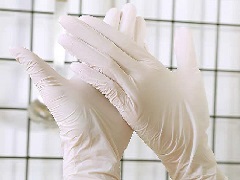Latex Gloves
Latex gloves, as the name implies, are gloves made from natural latex. Due to they are sanitary, latex gloves are easily disposable, effective and very affordable. Besides, they have little effect on touch, so medical staff can examine patients carefully to make an accurate diagnosis; latex gloves are also highly resistant to most chemicals, including bases and certain types of acids, they are highly resistant to water, and their leakage rate is low. People use them to wash dishes, doctors wear them during surgery, and forensic scientists wear latex gloves at crime scenes to prevent contamination of evidence and to avoid damaging fingerprints left on glass or other similar surfaces without holes. Researchers also use latex gloves to protect their hands when exposed to dangerous chemicals, as rubber latex is very durable and resistant to punctures and cuts.

Latex glove, for clinical hygiene protection.
General Standard for Latex Gloves
Table 1:
| Type | Powderd/Unpowdered |
|---|---|
| Material | 100% Latex |
| Width, mm | 75/83/89/95/102/108/114 |
| Tolerance, mm | ±6 |
| Length, mm | 220~230 |
| Thickness, mm, min | Finger(0.08)/Palm(0.08) |
| Color | Blue/White/Black |
Latex gloves fall into two categories. Type I -Gloves with a minimum tensile strength of 18MPa and a maximum stress at 500 % elongation of 5.5 MPa. Type II -Gloves with a minimum tensile strength of 14 MPa and a maximum stress at 500 % elongation of 2.8 MPa.
Table 2:
| Latex gloves | Before Aging | After Accelerated Aging | |||
|---|---|---|---|---|---|
| Tensile Strength | Stress at 500% El. | Ultimate El. | Tensile Strength | Ultimate El. | |
| Type 1 | 18 MPa min | 5.5 MPa max | 650% min | 14 MPa min | 500% min |
| Type 2 | 14 MPa min | 2.8 MPa max | 650% min | 14 MPa min | 500% min |
Testing for Latex Gloves
- Sterility Test: Sterility tests should be performed in accordance with the latest edition of the United States pharmacopoeia;
- Freedom from Holes: The no-hole free test shall be conducted in accordance with test method D 5151;
- Physical dimensions should be tested according to Practice D3767;
- The accelerated aging test was conducted according to test method D573. Test the gloves using either of the following methods: At a temperature of 166 + 2h at 70 + 2c, the tensile strength and ultimate elongation shall not be less than the values specified in table 2. This method shall be used as a condition for referee testing; At temperatures of 100 + 2c for 22 + 0.3h, tensile strength and ultimate tensile strength shall not be less than the values specified in table 2;
- Powder residue was determined by test method D6124.







